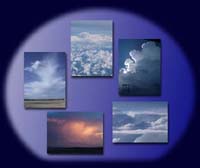Cirrus Clouds near an Aircraft
|
The number concentration of the ice crystals is extremely low within the Cirrus clouds. Therefore thin Cirrus clouds can be hardly noticed at high sun level, if the aircraft is within the cloud. Only if the horizontal extension of the cloud is large enough, sometimes a thin veil can be recognized. Because the cloud particles are quite large, they scatter the sun light preferentially in forward direction so that the Cirrus clouds become visible at "back-light position" of the sun. This is demonstrated in the following series of images. In Aircraft1.jpg Cirrus clouds can be recognized at the level of
the wings and above them at a cruising altitude of 11 km. In Aircraft2.jpg
the sun appears through the cloud veil that is therefore clearly
noticeable. Besides the sun is "washy", but not sharp
and circular. This indicates scattering at ice crystals. More details
can be found in the chapter Sun
through clouds. |
In Aircraft4.jpg even single fumes which move over the wings and thus are directly next to the aircraft can be noticed. Considering a flight velocity of 200 m/s the cloud air moves approximately one meter during the time of exposure of 1/200 s. Therefore the fumes over the wings are not clearly reproduced.
|
Aircraft1-5.jpg : S. Borrmann, flight from Frankfurt to Sao Paulo,
17/18 February 2004, 4:43 a.m. to 4:49 a.m. local time at Sao Paulo,
Brazil Olympus E-1 SLR with a 14-54 mm objective. Light exposure and ASA
sensitivity are chosen by program automation of the camera. Since
the illumination was very weak, the noise of the CCD recording element
affected quality. However, this could be reduced by the "noise
reduction" function of the camera. The images were taken in
the sRGB colour range with a resolution of 2560 x 1920 Pixel x 24
colours. |
![]()






